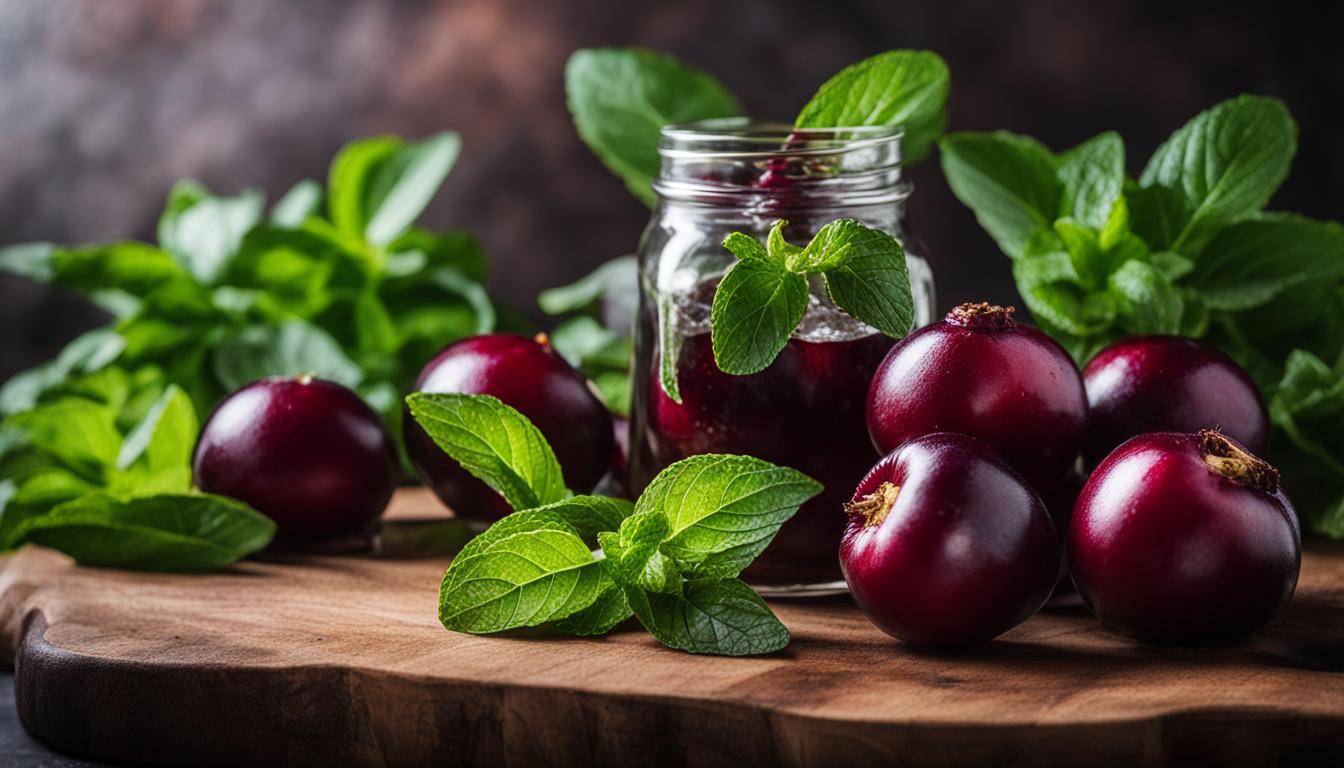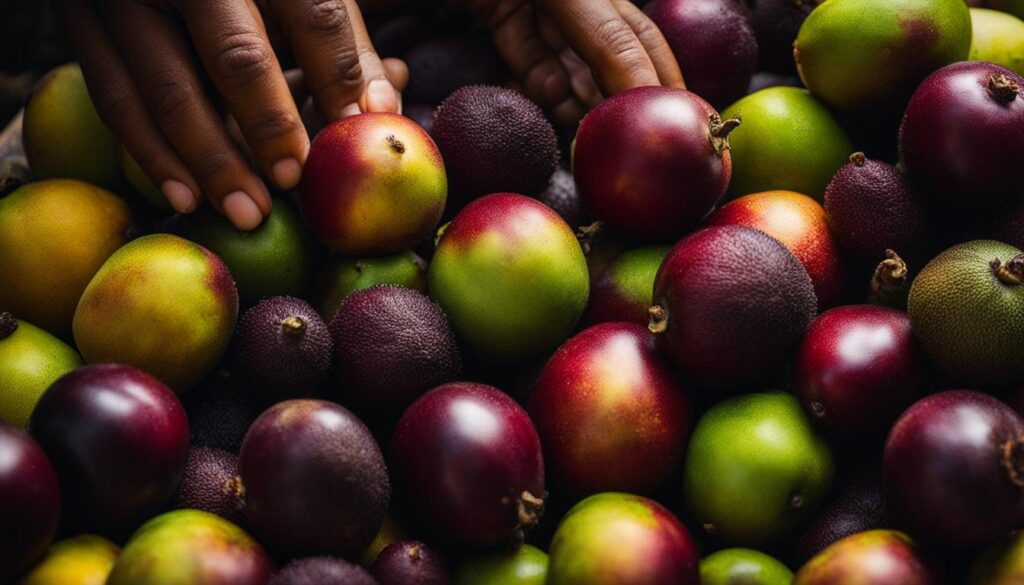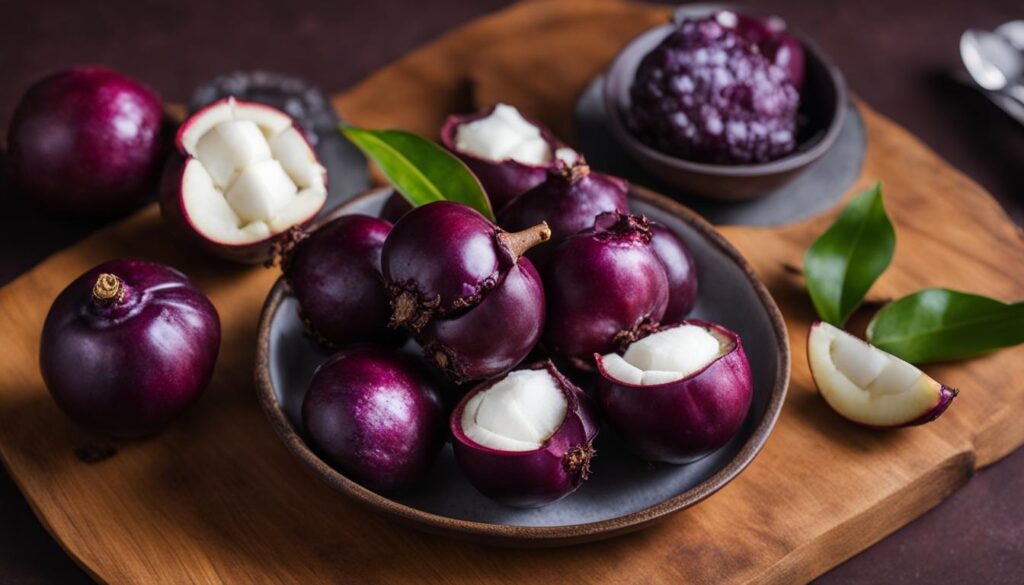Physical Address
304 North Cardinal St.
Dorchester Center, MA 02124
Physical Address
304 North Cardinal St.
Dorchester Center, MA 02124

Mangosteens are a beautiful and exotic tropical fruit that can be a bit challenging to store and preserve. In this guide, I will discuss the best methods for preserving mangosteen at home to enhance its longevity and preserve its unique flavor. Whether you want to extend the shelf life of mangosteen or simply want to keep it fresh for longer, these effective mangosteen preservation techniques will help you make the most of this exotic fruit.
Mangosteens are a delicate fruit that require proper storage to maintain their flavor and freshness. Here are some tips on how to store mangosteen:
By following these storage tips, you can extend the shelf life of mangosteen and preserve its unique flavor for longer.
Table: Comparing Different Storage Methods for Mangosteen
| Storage Method | Temperature | Shelf Life |
|---|---|---|
| Room Temperature | Around 10°C/50°F | A couple of days (fully ripe) up to 2 weeks (unripe) |
| Refrigeration | Not recommended, unless fridge temperature is 10-12°C/50-55°F | Shortens shelf life and affects flavor |
Source: Research and analysis of various mangosteen preservation techniques.
Here are some additional expert tips on how to store mangosteen:
By following these expert tips, you can ensure that your mangosteens stay fresh and delicious for longer periods.
When it comes to preserving mangosteen, freezing might seem like a convenient option. However, it’s important to note that freezing mangosteen is not recommended as it can negatively impact the unique flavor of the fruit. Mangosteen is best enjoyed fresh, so if you have a surplus and want to extend its shelf life, it’s better to explore other preservation methods.
Freezing mangosteen can alter its texture and taste, resulting in a less than desirable eating experience. The fruit contains high water content, which can lead to ice crystal formation during freezing and subsequent thawing, affecting the overall quality. To fully appreciate the delicate flavor profile of mangosteen, it’s best to consume it fresh or utilize alternative preservation techniques.
Instead of freezing, consider using other methods to prolong the lifespan of your mangosteen. Storing the fruit in a cool pantry at around 10-12°C/50-55°F is ideal for maintaining its freshness. If you have a large quantity of mangosteen that you won’t be able to consume before it ripens, you can even opt to make jam or preserves. Properly sterilized and tightly sealed containers can keep mangosteen jam or preserves well in a cold pantry for several months, allowing you to enjoy the fruit’s delightful flavor even when it’s out of season.
Overall, while freezing mangosteen may seem like a convenient option, it ultimately compromises the taste and texture of this exotic fruit. By exploring other preservation methods and embracing the fresh goodness of mangosteen, you can fully savor its distinct flavor and enjoy its tropical allure.

| Pros | Cons |
|---|---|
| – Convenient for long-term storage | – Alters the flavor and texture |
| – Allows for preservation of large quantities | – Ice crystal formation affects quality |
| – Can extend the shelf life of mangosteen | – Loss of freshness and vibrant taste |
| – Easy to thaw and use in recipes | – May result in mushy texture |
*Note: Freezing mangosteen is possible, but it is not recommended for optimal flavor and quality.
When you have a large quantity of mangosteens and cannot consume them all before they ripen, there are alternative methods for long-term storage. One option is to make mangosteen jam or preserves. Properly sterilized and tightly closed containers can keep mangosteen jam or preserves well in a cold pantry for months. While the flavor may not be as great as fresh mangosteens, it’s a viable option for storing mangosteens for an extended period.
To make mangosteen jam or preserves, start by removing the purple shell of the fruit and extracting the white flesh containing juicy pods with seeds. Chop the flesh into small pieces and remove any remaining seeds. Then, combine the chopped mangosteen flesh with sugar in a saucepan, using approximately equal parts of fruit and sugar. Add a splash of lemon juice for acidity and bring the mixture to a boil, stirring continuously. Reduce the heat and simmer until the mixture thickens to the desired consistency. Transfer the jam or preserves to sterilized jars, seal them tightly, and store them in a cool pantry.
Another option for long-term storage is to freeze mangosteen puree. Begin by extracting the flesh from the fruit, removing any seeds, and blending the pulp until smooth. Pour the puree into an ice cube tray or freezer-safe containers, leaving a little space for expansion. Place the tray or containers in the freezer and allow the puree to freeze completely. Once frozen, transfer the cubes or containers to a freezer bag or airtight container to prevent freezer burn. Frozen mangosteen puree can be kept for several months and used in smoothies, desserts, or sauces.
| Method | Preparation Time | Storage Duration |
|---|---|---|
| Mangosteen Jam or Preserves | Approximately 1 hour | Several months in a cool pantry |
| Frozen Mangosteen Puree | Varies based on quantity | Several months in the freezer |
Preserving mangosteen fruit for long-term storage helps ensure you can enjoy this exotic fruit even when it’s out of season. Whether you choose to make jam or freeze puree, these methods will help you savor the unique flavor of mangosteen for months to come.
When it comes to choosing the best mangosteens, there are a few key factors to keep in mind. By paying attention to the appearance and texture of the fruit, you can ensure that you select the ripest and most flavorful mangosteens available. Here are some tips on how to pick the best mangosteens:
By following these simple guidelines, you can select the best mangosteens and enjoy their delicious flavor at its peak. Remember, the appearance and texture of the fruit are key indicators of its quality, so trust your senses when making your selection.

| Factors to Consider | Best Mangosteens | Avoid |
|---|---|---|
| Color | Deep purple | Light purple or green |
| Appearance | Shiny and glossy | Dull or dry |
| Calyx (cap) | Green with fresh leaves | Dry or withered |
| Texture | Gives in slightly when squeezed | Too firm |
| Damage | No holes or resin discharge | Holes or resin discharge |
Mangosteens are not only delicious but also versatile in the kitchen. Here are some simple steps to help you prepare and make the most of this exotic fruit:
To prepare a mangosteen, start by cutting a horizontal incision in the middle of the fruit, being careful not to cut too deep. Then, gently twist the fruit to remove the purple shell. Once the shell is removed, you’ll reveal the fragrant white flesh of the mangosteen. The flesh consists of small juicy pods, each containing a seed, which are perfectly edible.
Mangosteens can be enjoyed fresh on their own, offering a unique and refreshing flavor. However, they can also be used in various dishes and recipes to add a hint of tropical sweetness. Here are some delicious ways to use mangosteens:
The possibilities are endless when it comes to using mangosteens in your culinary creations. Let your creativity flow and experiment with different flavor combinations to truly savor the tropical delight of mangosteens.

| Recipe | Ingredients | Instructions |
|---|---|---|
| Mangosteen Fruit Salad |
|
|
| Mangosteen Curry |
|
|
Whether you prefer enjoying mangosteens fresh or incorporating them into your favorite recipes, this tropical fruit is sure to add a delightful touch to your dining experience. So go ahead, experiment with different flavors, and savor the unique taste of mangosteens!
Preserving mangosteen can be a rewarding experience. By following the proper storage methods and utilizing different preservation techniques, you can enjoy the unique flavor of mangosteens for an extended period. Whether you prefer consuming them fresh or using them in various recipes, these preservation tips will help you make the most of this exotic fruit. Experiment with different methods and enjoy the deliciousness of mangosteens at home.
Mangosteens should be stored at a cold pantry temperature of around 10°C/50°F. Avoid keeping them in the fridge, as it can affect the flavor and texture of the fruit. At room temperature, fully ripe mangosteens can last a couple of days, while unripe mangosteens can last up to 2 weeks. For long-term storage, it’s best to purchase slightly unripe mangosteens, as they will continue to ripen over time. Consider keeping ripe and unripe mangosteens separately to use them at different times.
Freezing mangosteens is not recommended, as it can ruin the unique flavor of the fruit. It’s best to consume mangosteens fresh or use other preservation methods if you have a surplus. Avoid refrigerating mangosteens unless your fridge temperature is at 10-12°C/50-55°F, as they are sensitive to cold temperatures.
If you have a large quantity of mangosteens and cannot consume them all before they ripen, you can consider making jam or preserves. Properly sterilized and tightly closed containers can keep mangosteen jam or preserves well in a cold pantry for months. While the flavor may not be as great as fresh mangosteens, it’s a viable option for storing mangosteens for an extended period.
When selecting mangosteens, look for deep purple fruits with a shiny appearance and a green cap with leaves. The fruits should give in slightly when you apply pressure with your thumb, indicating that they are fully ripe. Avoid fruits with holes or resin discharge on their skins, as it signifies damage by insects. Consider buying a mix of slightly more ripe and firm mangosteens if you plan to consume them at different times.
Preparing mangosteens is relatively simple. Cut a horizontal incision in the middle of the fruit and twist it to remove the purple shell, revealing the fragrant white flesh. The flesh contains juicy pods with seeds that can be eaten directly or used in various dishes. Mangosteens can be enjoyed fresh on their own or added to fruit salads, vegetables, stir-fries, smoothies, cocktails, and juices. They can also be used in curries, sorbets, and various desserts, allowing for culinary creativity.

I’m Rachel Cooper, the brain and heart behind AboutWeirdFruits. If you’re here, you probably share the same insatiable curiosity for the fascinating world of exotic fruits that I do. From the spiky Durian to the unique Buddha’s Hand, I’ve been captivated by the diversity, flavors, and benefits these rare fruits bring into our lives.